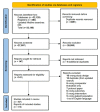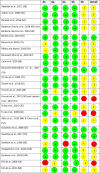The effect of preoperative behaviour change interventions on pre- and post-surgery health behaviours, health outcomes, and health inequalities in adults: A systematic review and meta-analyses
- PMID: 37406002
- PMCID: PMC10321619
- DOI: 10.1371/journal.pone.0286757
The effect of preoperative behaviour change interventions on pre- and post-surgery health behaviours, health outcomes, and health inequalities in adults: A systematic review and meta-analyses
Abstract
Background: Prehabilitation interventions are being delivered across surgical specialities to improve health risk behaviours leading to better surgical outcomes and potentially reduce length of hospital stay. Most previous research has focused on specific surgery specialities and has not considered the impact of interventions on health inequalities, nor whether prehabilitation improves health behaviour risk profiles beyond surgery. The aim of this review was to examine behavioural Prehabilitation interventions across surgeries to inform policy makers and commissioners of the best available evidence.
Methods and findings: A systematic review and meta-analysis of randomised controlled trials (RCTs) was conducted to determine the effect of behavioural prehabilitation interventions targeting at least one of: smoking behaviour, alcohol use, physical activity, dietary intake (including weight loss interventions) on pre- and post-surgery health behaviours, health outcomes, and health inequalities. The comparator was usual care or no treatment. MEDLINE, PubMed, PsychINFO, CINAHL, Web of Science, Google Scholar, Clinical trials and Embase databases were searched from inception to May 2021, and the MEDLINE search was updated twice, most recently in March 2023. Two reviewers independently identified eligible studies, extracted data, and assessed risk of bias using the Cochrane risk of bias tool. Outcomes were length of stay, six-minute walk test, behaviours (smoking, diet, physical activity, weight change, and alcohol), and quality of life. Sixty-seven trials were included; 49 interventions targeted a single behaviour and 18 targeted multiple behaviours. No trials examined effects by equality measures. Length of stay in the intervention group was 1.5 days shorter than the comparator (n = 9 trials, 95% CI -2.6 to -0.4, p = 0.01, I2 83%), although in sensitivity analysis prehabilitation had the most impact in lung cancer patients (-3.5 days). Pre-surgery, there was a mean difference of 31.8 m in the six-minute walk test favouring the prehabilitation group (n = 19 trials, 95% CI 21.2 to 42.4m, I2 55%, P <0.001) and this was sustained to 4-weeks post-surgery (n = 9 trials, mean difference = 34.4m (95%CI 12.8 to 56.0, I2 72%, P = 0.002)). Smoking cessation was greater in the prehabilitation group before surgery (RR 2.9, 95% CI 1.7 to 4.8, I2 84%), and this was sustained at 12 months post-surgery (RR 1.74 (95% CI 1.20 to 2.55, I2 43%, Tau2 0.09, p = 0.004)There was no difference in pre-surgery quality of life (n = 12 trials) or BMI (n = 4 trials).
Conclusions: Behavioural prehabilitation interventions reduced length of stay by 1.5 days, although in sensitivity analysis the difference was only found for Prehabilitation interventions for lung cancer. Prehabilitation can improve functional capacity and smoking outcomes just before surgery. That improvements in smoking outcomes were sustained at 12-months post-surgery suggests that the surgical encounter holds promise as a teachable moment for longer-term behavioural change. Given the paucity of data on the effects on other behavioural risk factors, more research grounded in behavioural science and with longer-term follow-up is needed to further investigate this potential.
Copyright: © 2023 Fong et al. This is an open access article distributed under the terms of the Creative Commons Attribution License, which permits unrestricted use, distribution, and reproduction in any medium, provided the original author and source are credited.
Conflict of interest statement
No authors have competing interest.
Figures







Similar articles
-
Pre-admission interventions (prehabilitation) to improve outcome after major elective surgery: a systematic review and meta-analysis.BMJ Open. 2021 Sep 30;11(9):e050806. doi: 10.1136/bmjopen-2021-050806. BMJ Open. 2021. PMID: 34593498 Free PMC article.
-
Multiple versus single risk behaviour interventions for people with severe mental illness: a network meta-analysis and qualitative synthesis.Southampton (UK): NIHR Journals Library; 2022 Mar. Southampton (UK): NIHR Journals Library; 2022 Mar. PMID: 35324135 Free Books & Documents. Review.
-
Beyond the black stump: rapid reviews of health research issues affecting regional, rural and remote Australia.Med J Aust. 2020 Dec;213 Suppl 11:S3-S32.e1. doi: 10.5694/mja2.50881. Med J Aust. 2020. PMID: 33314144
-
Effectiveness of Prehabilitation Modalities on Postoperative Outcomes Following Colorectal Cancer Surgery: A Systematic Review of Randomised Controlled Trials.Ann Surg Oncol. 2024 Nov;31(12):7822-7849. doi: 10.1245/s10434-024-15593-2. Epub 2024 Jun 24. Ann Surg Oncol. 2024. PMID: 38914837 Free PMC article.
-
The effectiveness of smoking cessation, alcohol reduction, diet and physical activity interventions in changing behaviours during pregnancy: A systematic review of systematic reviews.PLoS One. 2020 May 29;15(5):e0232774. doi: 10.1371/journal.pone.0232774. eCollection 2020. PLoS One. 2020. PMID: 32469872 Free PMC article.
Cited by
-
The inequalities and challenges of prehabilitation before cancer surgery: a narrative review.Anaesthesia. 2025 Feb;80 Suppl 2(Suppl 2):75-84. doi: 10.1111/anae.16502. Epub 2025 Jan 8. Anaesthesia. 2025. PMID: 39775660 Free PMC article. Review.
-
Impact on postoperative complications of combined prehabilitation targeting co-existing smoking, malnutrition, obesity, alcohol drinking, and physical inactivity: a systematic review and meta-analysis of randomised trials.F1000Res. 2025 Apr 8;13:694. doi: 10.12688/f1000research.150880.2. eCollection 2024. F1000Res. 2025. PMID: 40574788 Free PMC article.
-
Redesigning the Care of Musculoskeletal Conditions With Lifestyle Medicine.Mayo Clin Proc Innov Qual Outcomes. 2024 Aug 12;8(5):418-430. doi: 10.1016/j.mayocpiqo.2024.07.001. eCollection 2024 Oct. Mayo Clin Proc Innov Qual Outcomes. 2024. PMID: 39228921 Free PMC article.
-
Exploring factors associated with postoperative physical activity and sedentary behavior in newly diagnosed lung cancer patients: a cross-sectional study.Support Care Cancer. 2024 Aug 21;32(9):605. doi: 10.1007/s00520-024-08805-8. Support Care Cancer. 2024. PMID: 39167202
-
Multi-Modal Prehabilitation in Thoracic Surgery: From Basic Concepts to Practical Modalities.J Clin Med. 2024 May 8;13(10):2765. doi: 10.3390/jcm13102765. J Clin Med. 2024. PMID: 38792307 Free PMC article. Review.
References
-
- Organisation for Economic Co-operation and Development (OECD). Waiting times 2020. [Available from: https://www.oecd.org/els/health-systems/waiting-times.htm.
-
- NHS England. Delivery plan for tackling the COVID-19 backlog of elective care. 2022. - PubMed
Publication types
MeSH terms
Grants and funding
LinkOut - more resources
Full Text Sources
Medical

